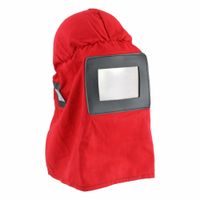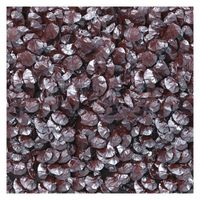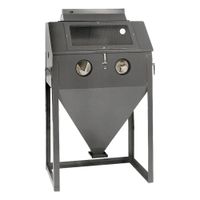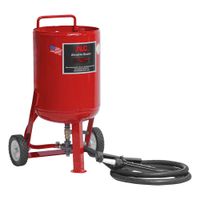Call +(254) 703 030 000 / 751 483 999 / 721 704 777
.....Read More
Frequently Asked Questions
What is abrasive blasting used for?
Abrasive blasting, also known as sandblasting, is a process used to propel abrasive material against a surface under high pressure to smooth a rough surface, roughen a smooth surface, shape a surface, or remove surface contaminants. It is commonly used for surface preparation before painting or coating, removing rust, scale, or old paint from metal, and preparing surfaces for bonding. Additionally, abrasive blasting can be used for etching glass, cleaning masonry, or providing a matte finish on various materials. The type of abrasive material used, such as sand, glass beads, or walnut shells, depends on the desired outcome and the material being blasted.
How does abrasive blasting work?
Abrasive blasting, also known as sandblasting, is a surface finishing process that propels a stream of abrasive material against a surface under high pressure to smooth a rough surface, roughen a smooth surface, shape a surface, or remove surface contaminants. The process typically involves an air compressor that generates pressurized air, a blast pot or machine that holds the abrasive media, and a nozzle through which the abrasive is propelled.
When the compressed air is introduced into the blast pot, it mixes with the abrasive media (such as sand, steel grit, glass beads, or walnut shells) and forces it out through the nozzle at high velocity. The impact of these abrasive particles on the target surface creates the desired effect, whether it's cleaning, texturing, or preparing the surface for subsequent coatings or treatments. The type of abrasive media, the pressure of the air, and the angle of the nozzle all influence the outcome of the blasting process.
What types of abrasive media are used in blasting?
Abrasive blasting utilizes various media, each with unique characteristics suited for different applications. Common types include: * **Garnet:** A naturally occurring mineral, garnet is known for its hardness, durability, and low dust generation. It's widely used for general-purpose blasting, surface preparation, and removing rust and coatings. Its angular shape provides an aggressive cutting action.
* **Aluminum Oxide:** A synthetic, very hard abrasive, aluminum oxide is ideal for aggressive cleaning, etching, and preparing surfaces for bonding. It comes in various grit sizes, allowing for precise control over surface profile.
* **Glass Beads:** Made from recycled glass, these spherical beads produce a smooth, polished finish without removing base material. They are excellent for peening, deburring, and light cleaning where surface integrity is crucial.
* **Steel Shot and Grit:** These metallic abrasives are highly durable and recyclable. Steel shot (spherical) is used for peening, strengthening metal parts, and creating a smooth finish, while steel grit (angular) is used for aggressive cleaning and creating a rough profile for subsequent coatings.
* **Walnut Shells and Corn Cobs:** These organic, biodegradable media are much softer than mineral or metallic abrasives. They are used for delicate cleaning, deburring, and paint stripping on sensitive materials like wood, plastic, and soft metals, as they are non-abrasive to the substrate.
* **Plastic Media:** Typically made from thermoset plastics, plastic media is another soft abrasive used for stripping paint, coatings, and contaminants from delicate surfaces, especially in aerospace and automotive industries, without causing damage.The choice of abrasive media depends on the desired surface finish, the material being blasted, and the nature of the contaminant or coating to be removed.
What safety equipment is needed for abrasive blasting?
Abrasive blasting requires specific safety equipment to protect workers from hazards such as dust, flying particles, and noise. Key personal protective equipment (PPE) includes a blast helmet with a fresh air supply to prevent inhalation of harmful dust, hearing protection like earplugs or earmuffs, and heavy-duty gloves to shield hands from abrasive materials. Workers should also wear appropriate body protection such as a blast suit or heavy-duty overalls, safety boots with steel toes, and eye protection (though the helmet often covers this). Respiratory protection is paramount, so a NIOSH-approved respirator with a tight face seal is crucial if a full blast helmet is not used. Additionally, proper ventilation in the work area is essential to control dust levels.
How do you choose the right abrasive media for a project?
Choosing the right abrasive media for a project is crucial for achieving desired results and optimizing efficiency. Several factors should be considered:
First, identify the material being worked on. Different materials, such as metal, wood, or stone, require specific types of abrasive media. For instance, aluminum oxide is common for general-purpose applications on metals, while silicon carbide excels on hard, brittle materials like glass or ceramics.
Second, consider the desired surface finish. A coarser grit will remove material more aggressively and leave a rougher finish, suitable for heavy rust removal or shaping. Finer grits produce smoother finishes, ideal for polishing or preparing a surface for coating.
Third, assess the current condition of the workpiece. If there's heavy rust, paint, or scale, a more aggressive, coarser abrasive might be needed initially. For lighter cleaning or surface preparation, a finer media might suffice.
Fourth, determine the desired outcome of the abrasive process. Are you looking to clean, deburr, polish, create a specific profile, or prepare for coating? Each objective may necessitate a different media type and size.
Fifth, consider the type of blasting equipment being used. Different equipment, such as blast cabinets, portable blasters, or automated systems, may have limitations on the types or sizes of media they can effectively use.
Finally, consider environmental and safety factors. Some abrasive media can produce more dust or require specific ventilation. Always prioritize safety and environmental regulations when selecting and using abrasive materials. By carefully evaluating these factors, you can select the most appropriate abrasive media for your project, ensuring effective and efficient results.
What are the benefits of using a blasting cabinet?
Blasting cabinets offer a controlled and contained environment for various abrasive blasting applications, providing several key benefits. Primarily, they enhance safety by enclosing the blasting process, preventing abrasive media, dust, and debris from escaping into the workspace. This containment also protects operators from direct exposure to airborne particles and high-velocity abrasives.
Furthermore, blasting cabinets contribute to a cleaner and more organized work area. The media recovery and recycling systems often integrated into these units help to collect and reuse abrasive media, significantly reducing waste and operating costs. This reusability makes the process more environmentally friendly and economical.
The controlled environment within a cabinet allows for more consistent and precise blasting results. Operators can maintain better control over the blasting parameters, such as air pressure and media flow, leading to improved surface preparation, cleaning, or finishing. This precision is especially beneficial for delicate or intricate parts.
Finally, blasting cabinets are versatile, accommodating a wide range of abrasive media, from glass beads and aluminum oxide to plastic media and steel grit, making them suitable for diverse applications like rust removal, paint stripping, deburring, and surface profiling.
How do you maintain an abrasive blasting system?
Maintaining an abrasive blasting system involves several key steps to ensure its efficient operation, longevity, and operator safety. Regular inspections are crucial. This includes checking hoses, nozzles, and blast pots for wear, cracks, or blockages before and after each use. Worn nozzles can significantly reduce blasting efficiency and increase media consumption.
The abrasive media itself needs proper management. Ensure the media is clean, dry, and free of contaminants. Moisture can cause clogging and poor performance. If using a reclaim system, regularly clean or replace the dust collector filters to maintain proper airflow and prevent dust accumulation, which can affect visibility and air quality. Periodically inspect the abrasive separator to ensure it's effectively removing fines and oversized particles from the reusable media, preventing damage to the equipment and improving surface finish.
Lubrication of moving parts, such as those in the blast pot or associated machinery, should follow the manufacturer's recommendations. Air compressor maintenance is also vital, including checking oil levels, changing filters, and draining moisture from the air receiver tank.
Finally, always adhere to safety protocols. Inspect personal protective equipment (PPE) like helmets, gloves, and respirators for damage. Ensure ventilation systems are working correctly to minimize dust exposure. By following these maintenance practices, you can optimize the system's performance, reduce downtime, and ensure a safer working environment.
What are the environmental concerns with abrasive blasting?
Abrasive blasting can raise several environmental concerns. One major issue is airborne particulate matter. The blasting process generates fine dust particles from the abrasive material, the blasted surface, and any coatings present. These particles can disperse into the atmosphere, potentially impacting air quality and contributing to respiratory problems for workers and nearby communities.
Another concern is the disposal of spent abrasive materials. Depending on the blasted surface, these materials can become contaminated with heavy metals, paint residues, and other hazardous substances. Improper disposal can lead to soil and water contamination, posing risks to ecosystems and human health.
Noise pollution is also a factor, as abrasive blasting equipment can be very loud, causing disturbances to surrounding areas. Additionally, if the blasting is done outdoors, it can impact local flora and fauna. Runoff from wet blasting or cleanup can carry contaminants into drains and waterways. Therefore, proper containment, ventilation, and waste management practices are crucial to mitigate these environmental impacts.
How do you prevent damage to surfaces during abrasive blasting?
Preventing damage to surfaces during abrasive blasting is crucial for effective and safe operation. Key strategies include:1. **Selecting the Right Abrasive:** Different surfaces require different abrasives. Softer materials like plastic or wood need gentler abrasives (e.g., plastic media, walnut shells, corn cob), while harder materials like steel can withstand more aggressive options (e.g., steel grit, garnet). The size and shape of the abrasive also play a role; finer media causes less impact.
2. **Controlling Blast Pressure:** The pressure at which the abrasive is delivered directly affects its impact. Lowering the blast pressure can significantly reduce the risk of surface damage, especially on delicate or thin materials. Start with a lower pressure and gradually increase if necessary, while monitoring the surface.
3. **Nozzle Selection and Distance:** The type of nozzle (e.g., straight bore, venturi) influences the blast pattern and intensity. Holding the nozzle at an appropriate distance from the surface is also vital. Too close can cause excessive impact, while too far can reduce efficiency. Maintain a consistent distance for even results.
4. **Angle of Attack:** The angle at which the abrasive stream hits the surface can impact the outcome. A more acute angle (closer to parallel with the surface) generally causes less aggressive erosion and can be used for cleaning without significant material removal. A more direct, perpendicular angle is used for faster material removal but increases the risk of damage.
5. **Test Blasting:** Before beginning full-scale blasting, always conduct a test blast on an inconspicuous area or a sample piece of the same material. This allows you to fine-tune your parameters (abrasive type, pressure, distance, angle) to achieve the desired result without damaging the main surface.
6. **Masking and Shielding:** Protect areas that should not be blasted by masking them off with appropriate materials (e.g., heavy-duty tape, rubber sheets, specialized blasting covers). This prevents accidental etching or damage to adjacent surfaces.By carefully considering these factors, operators can effectively prevent damage to surfaces during abrasive blasting, ensuring a successful and controlled process.
What industries commonly use abrasive blasting?
Abrasive blasting, also known as sandblasting, is a versatile surface preparation method used across a wide range of industries for cleaning, deburring, shaping, or roughening a surface. Key industries that commonly utilize abrasive blasting include:1. Construction: Used for preparing concrete surfaces for coatings, removing old paint from bridges, and cleaning structural steel.
2. Automotive: Essential for stripping paint and rust from vehicle bodies, preparing parts for powder coating, and cleaning engine components.
3. Aerospace: Critical for cleaning and preparing delicate aircraft parts, such as turbine blades, and for shot peening to improve fatigue life.
4. Marine: Employed to remove barnacles, rust, and old paint from ship hulls and other marine structures before repainting.
5. Manufacturing and Fabrication: Used for deburring machined parts, creating specific surface finishes, and preparing metal for welding or painting.
6. Oil and Gas: Vital for cleaning and preparing pipelines, storage tanks, and drilling equipment to prevent corrosion and ensure structural integrity.
7. Restoration: Used to carefully remove layers of grime, paint, or corrosion from historical buildings, monuments, and antique items without causing damage.
8. Art and Design: Artists use abrasive blasting for etching glass, creating textures on various materials, and shaping sculptures.






